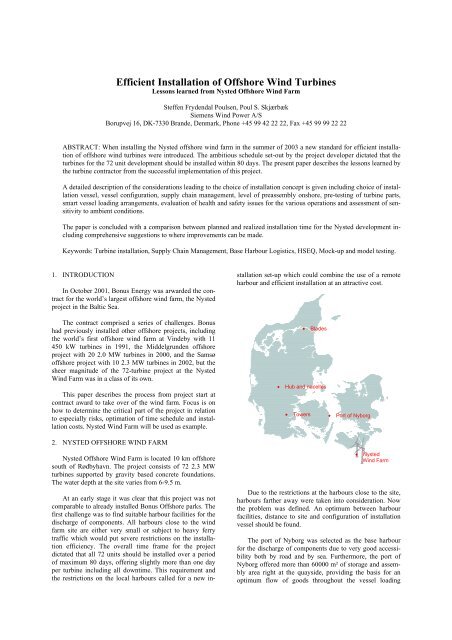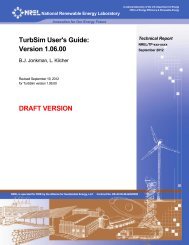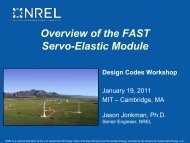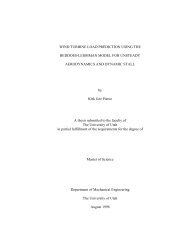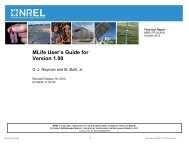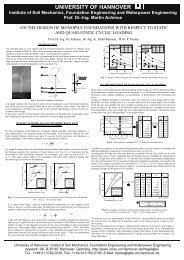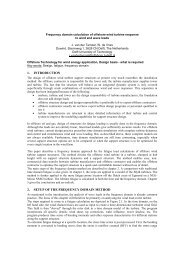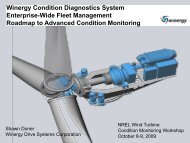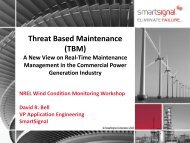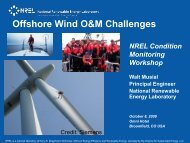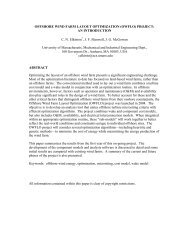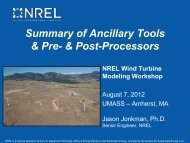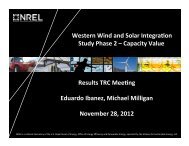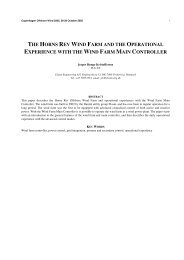MEASUREMENT OF LOADS ON WINDTURBINES
MEASUREMENT OF LOADS ON WINDTURBINES
MEASUREMENT OF LOADS ON WINDTURBINES
Create successful ePaper yourself
Turn your PDF publications into a flip-book with our unique Google optimized e-Paper software.
Efficient Installation of Offshore Wind Turbines<br />
Lessons learned from Nysted Offshore Wind Farm<br />
Steffen Frydendal Poulsen, Poul S. Skjærbæk<br />
Siemens Wind Power A/S<br />
Borupvej 16, DK-7330 Brande, Denmark, Phone +45 99 42 22 22, Fax +45 99 99 22 22<br />
ABSTRACT: When installing the Nysted offshore wind farm in the summer of 2003 a new standard for efficient installation<br />
of offshore wind turbines were introduced. The ambitious schedule set-out by the project developer dictated that the<br />
turbines for the 72 unit development should be installed within 80 days. The present paper describes the lessons learned by<br />
the turbine contractor from the successful implementation of this project.<br />
A detailed description of the considerations leading to the choice of installation concept is given including choice of installation<br />
vessel, vessel configuration, supply chain management, level of preassembly onshore, pre-testing of turbine parts,<br />
smart vessel loading arrangements, evaluation of health and safety issues for the various operations and assessment of sensitivity<br />
to ambient conditions.<br />
The paper is concluded with a comparison between planned and realized installation time for the Nysted development including<br />
comprehensive suggestions to where improvements can be made.<br />
Keywords: Turbine installation, Supply Chain Management, Base Harbour Logistics, HSEQ, Mock-up and model testing.<br />
1. INTRODUCTI<strong>ON</strong><br />
In October 2001, Bonus Energy was arwarded the contract<br />
for the world’s largest offshore wind farm, the Nysted<br />
project in the Baltic Sea.<br />
The contract comprised a series of challenges. Bonus<br />
had previously installed other offshore projects, including<br />
the world’s first offshore wind farm at Vindeby with 11<br />
450 kW turbines in 1991, the Middelgrunden offshore<br />
project with 20 2.0 MW turbines in 2000, and the Samsø<br />
offshore project with 10 2.3 MW turbines in 2002, but the<br />
sheer magnitude of the 72-turbine project at the Nysted<br />
Wind Farm was in a class of its own.<br />
This paper describes the process from project start at<br />
contract award to take over of the wind farm. Focus is on<br />
how to determine the critical part of the project in relation<br />
to especially risks, optimation of time schedule and installation<br />
costs. Nysted Wind Farm will be used as example.<br />
At an early stage it was clear that this project was not<br />
comparable to already installed Bonus Offshore parks. The<br />
first challenge was to find suitable harbour facilities for the<br />
discharge of components. All harbours close to the wind<br />
farm site are either very small or subject to heavy ferry<br />
traffic which would put severe restrictions on the installation<br />
efficiency. The overall time frame for the project<br />
dictated that all 72 units should be installed over a period<br />
of maximum 80 days, offering slightly more than one day<br />
per turbine including all downtime. This requirement and<br />
the restrictions on the local harbours called for a new installation<br />
set-up which could combine the use of a remote<br />
harbour and efficient installation at an attractive cost.<br />
• Blades<br />
• Hub and nacelles<br />
• Towers • Port of Nyborg<br />
2. NYSTED <strong>OF</strong>FSHORE WIND FARM<br />
Nysted Offshore Wind Farm is located 10 km offshore<br />
south of Rødbyhavn. The project consists of 72 2.3 MW<br />
turbines supported by gravity based concrete foundations.<br />
The water depth at the site varies from 6-9.5 m.<br />
• Nysted<br />
Wind Farm<br />
Due to the restrictions at the harbours close to the site,<br />
harbours farther away were taken into consideration. Now<br />
the problem was defined. An optimum between harbour<br />
facilities, distance to site and configuration of installation<br />
vessel should be found.<br />
The port of Nyborg was selected as the base harbour<br />
for the discharge of components due to very good accessibility<br />
both by road and by sea. Furthermore, the port of<br />
Nyborg offered more than 60000 m² of storage and assembly<br />
area right at the quayside, providing the basis for an<br />
optimum flow of goods throughout the vessel loading
process. The total supply of turbines and equipment at the<br />
quayside required more than 700 truck loads, obviously<br />
requiring a high degree of flexibility at the unloading area.<br />
The only disadvantage of the port of Nyborg was that it<br />
was located more than 80 nautical miles from the wind<br />
farm site, resulting in an 11-hour run at favourable weather<br />
conditions.<br />
3. TIME C<strong>ON</strong>SUMING TASKS<br />
The project can be divided into the following main tasks:<br />
• Design Review<br />
• Tower Mock Up<br />
• Preparing installation vessel<br />
• Preparing base harbour<br />
• Nacelle Assembling<br />
• Hub Assembling<br />
• Blade Manufacturing<br />
• Onshore Transportation<br />
• Rotor Assembling<br />
• Tower Assembling<br />
• Vessel Loading<br />
• Wind Turbine erection<br />
• Commissioning<br />
Design Review<br />
At the time of contract the chosen wind turbine, Bonus<br />
2.3 MW, was at a stage of upgrade from the 2.0 MW. The<br />
2.0 MW was installed at Middelgrunden offshore project in<br />
2000, but still the turbine needed a detailed design review<br />
to get into a 2.3 MW version for offshore application. The<br />
design review included the entire turbine design, and experiences<br />
from the already operating 2.0 MW turbines were<br />
an important basis for the design review.<br />
At the design review experiences from all offshore aspects<br />
from the Middelgrunden project was taken into account.<br />
This includes quality, service, health and safety,<br />
onshore pretests, offshore transportation and installation.<br />
Tower Mock Up<br />
When designing a tower the main issue is to get an optimum<br />
structural solution. With a fixed structure all internal<br />
parts can be designed. This includes necessary fittings,<br />
platforms, lift, and all electrical equipment. This involves<br />
many details, fittings and considerations about how to<br />
replace components as easy as possible. With 3D design<br />
tools, arrangement of all components in the tower bottom is<br />
getting easier and safer than earlier. Even with these advanced<br />
tools something can be missed.<br />
To avoid mistakes a tower mock up was made. A tower<br />
mock up is a dummy section of the lower 10 meters of the<br />
tower structure. All internal parts are mounted in the mock<br />
up, and replacement of main components is tested. Pulling<br />
of sea cables was also tested. The purpose of the mock up<br />
was to eliminate any inappropriate design details in time.<br />
The mock up activities resulted in repairing many minor<br />
problems. Changing a fitting does not involve considerable<br />
costs, but if assembling of each tower is disturbed by<br />
adjustment of fittings the tower assembling flow and<br />
thereby the time schedule will be influenced. It is even<br />
worse if replacement of components or maintenance of the<br />
turbine offshore requires changes or unnecessary man and<br />
vessel hours offshore.<br />
Preparing installation vessel<br />
After a detailed analysis of available installation vessels,<br />
the special built installation vessel, Ocean Ady was<br />
chosen for the job. The Ocean Ady is a modified container<br />
ship, fitted with four supporting legs and a lattice boom<br />
crane. Previously, the Ocean Ady had been used for offshore<br />
wind turbine installation using a setup where two<br />
complete wind turbines were installed per round trip. In<br />
order to reach the required installation rate, the vessel was<br />
modified to meet a capacity requirement of four complete<br />
wind turbines.<br />
One of the modifications was a special rack for stacking<br />
four rotors on top of each other. Placed on the deck, the<br />
rack was more than 12 meters high, requiring special attention<br />
to safe working conditions both during loading and<br />
installation off shore. In order to ensure that all operations<br />
would work and that all working processes would be safe, a<br />
complete mock up of the rotor rack was made well in<br />
advance of the start-up of installation works. Based on<br />
experiences from the mock-up, a series of modifications<br />
were introduced in order to obtain the best possible working<br />
environment.<br />
Preparing base harbour<br />
At the harbour area in Nyborg, a flow arrangement was<br />
established whereby pre-assembled tower sections, nacelles<br />
and blades would meet at the quayside in order to be ready<br />
for loading onto installation vessel immediately upon<br />
arrival.<br />
In addition to installation and loading area the base<br />
harbour served as a buffer for the flow of wind turbine<br />
parts.<br />
Nacelle and Hub Assembling<br />
Assembling of nacelle and hub is normally not affected<br />
of significant project specific requirements. Therefore this<br />
part will typically not be optimized specifically for the<br />
project, which also was the case for this project.
Blade Manufacturing<br />
As for the nacelle and hub assembling, the blades will<br />
not be affected significant by project specific requirements.<br />
Onshore Transportation<br />
For Nysted Offshore Wind Farm, the port of Nyborg<br />
was used as base harbour. This means that the assembled<br />
hubs, nacelles and surface treated blades and towers were<br />
delivered at the quayside at Nyborg. Hubs and nacelles<br />
were shipped by trucks from Brande to Nyborg. These<br />
transports did not require significant deviations from normal<br />
truck transports. Due to the blade length of 40 meter,<br />
the blade transports required a larger turning radius. Towers<br />
were delivered directly from the supplier and all mounting<br />
of internal equipped happened at the quayside.<br />
Rotor Assembling<br />
As described the installation vessel was prepared to<br />
transport assembled rotors. At the harbour a part of the area<br />
was allocated for rotor assembling. The pre-assembled hub<br />
was placed on a special foundation, and a well prepared<br />
crane set-up ensured that the three blades could be mounted<br />
very efficient. In that way the rotor assembling was decoupled<br />
from the vessel operation. Further the assembling<br />
at the harbour ensures optimal work environment and best<br />
possible conditions in relation to construction quality.<br />
Wind Turbine erection<br />
The wind turbine erection was split into four crane operations<br />
• Tower bottom section<br />
• Tower top section<br />
• Nacelle<br />
• Rotor<br />
When placing each of the four components, the service<br />
staff did immediately fasten the necessary bolts. Then the<br />
vessel could continue to the next foundation.<br />
Tower Assembling<br />
All tower sections were assembled at the tower manufacturer.<br />
This had the advantage that this part did not require<br />
special working conditions at the harbour.<br />
Vessel loading<br />
Everything was prepared at the quayside to load the<br />
vessel fastest possible. Immediately after arrival the vessel<br />
loading was started. Obviously the critical path in the<br />
installation phase was the vessel. Erection of turbines was<br />
fully correlated to the efficiency of the vessel operations.<br />
When everything operated optimally, the installation vessel<br />
was loaded with four complete turbines in less than 12<br />
hours.<br />
On the sea transportation from Nyborg to the site, the<br />
service staff prepared for the erection. Again it was important<br />
that no time was wasted at the site.<br />
Commissioning<br />
After erection of the first wind turbines, commissioning<br />
was started. In that way the delay between the installation<br />
vessel and the commissioning was minimized.
4. SUPPLY CHAIN MANAGEMENT<br />
At an early stage of the project focus was on the flow<br />
from manufacturing over assembling of main components<br />
at own facilities to commissioning of the wind farm at the<br />
site. It is very important that the main time consuming<br />
tasks are highlighted. When these activities are identified it<br />
is possible to establish a planned buffer system.<br />
Based on a time schedule proposal, the critical path can<br />
be identified. At the same time the tasks on the critical path<br />
can be categorized due to costs, probability of excess and<br />
alternatives in case of mechanical breakdown. At the same<br />
time the probability of changing the critical path to another<br />
part of the flow shall be identified, and which consequences<br />
this will bring.<br />
loading of the vessel. On the 79 th day from the start up of<br />
installation, 72 nd and last turbine was delivered to its final<br />
destination at Nysted Wind Farm.<br />
The commissioning works commenced as soon as the<br />
first turbine had been installed and preceded on parallel to<br />
the installation. Grid connection was established in the<br />
beginning of July, 2003 and on July 13 th the first power<br />
was exported to shore. By the end of August, all turbines<br />
had been commissioned and were in automatic operation,<br />
and following a three-month adjustment and testing period,<br />
the project was taken over on December 1 st 2003, one<br />
month ahead of schedule.<br />
Some tasks on the critical path are not subject for further<br />
optimization. An example is the sea transport from<br />
Nyborg to the site and return. On the contrary the loading<br />
process of the vessel in Nyborg is an important subject for<br />
optimization.<br />
Establishment of a base harbour results in a logistic<br />
challenge due to transportation of turbine parts to the harbour<br />
by trucks. All supplies results in more than 700 truck<br />
loads. This part shall also be planned and coordinated to<br />
avoid wasted time.<br />
In the end it can be summarized that focus shall be on<br />
de-coupling of time consuming tasks with significant probability<br />
of excess. This can in some way be handled by<br />
introduction of a buffer system. If, no matter why, supply<br />
of e.g. blades is delayed compared to erection of turbines, it<br />
should be avoided that the erection will be affected. This<br />
can be handled by introduction of a buffer system.<br />
A natural part of the component flow at the base harbour<br />
is quality control. All components follow the same<br />
flow and thereby it is easy to establish an efficient quality<br />
control before and after assembling. Before vessel loading<br />
all relevant tests can be performed to avoid time delay in<br />
the commissioning phase offshore.<br />
5. DISCUSSI<strong>ON</strong><br />
From the very beginning the following points were in<br />
focus to get a successful project:<br />
• Design review of wind turbine to ensure sufficient<br />
quality for offshore application.<br />
• Optimizing the supply chain management with<br />
focus on the critical path.<br />
• Tuning the installation set-up to installation of all<br />
72 turbines within 80 days.<br />
• Health and safety aspects to be a natural part of<br />
the entire process.<br />
On May 11 th 2003, the first turbine installation commenced<br />
at Nysted wind Farm, and after fine-tuning of the<br />
work procedures during the first two round trips, the installation<br />
pace reached the required one turbine installation per<br />
day. When weather conditions were optimal, a round trip<br />
could be done in 72 hours, equaling 18 hours per turbine<br />
installed including transportation to and from the site and


